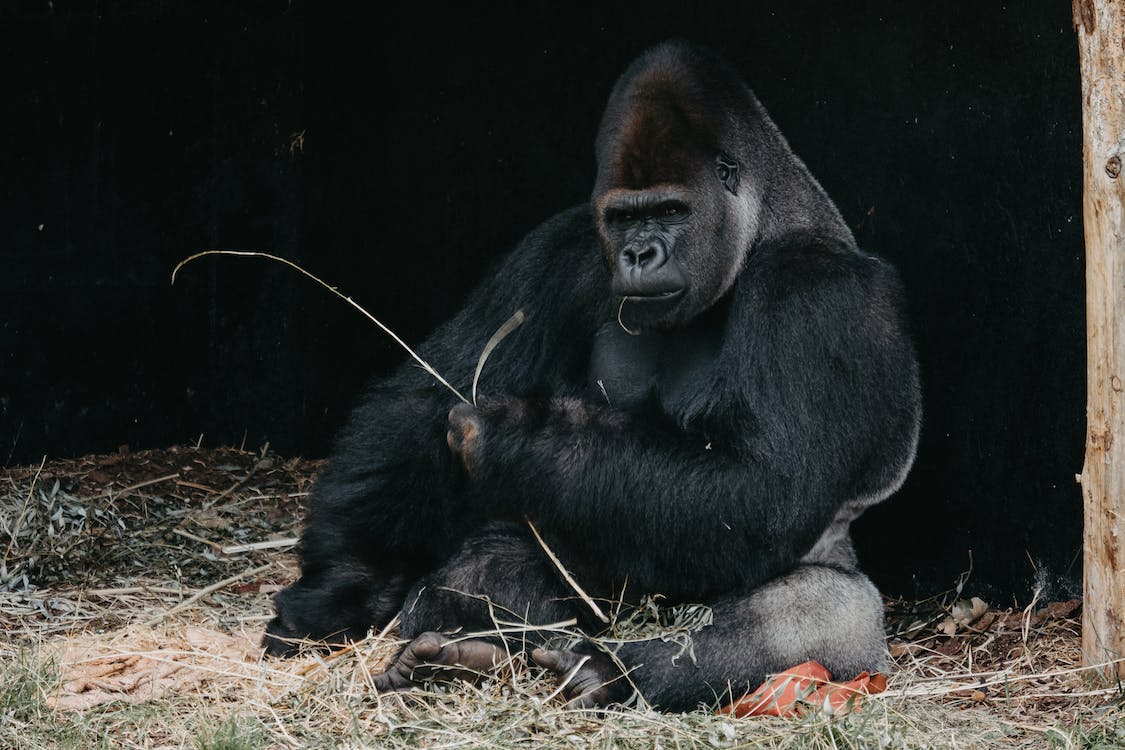Gorilla Fun Facts: Did you know that a gorilla’s DNA is 98% identical to humans? Uncover 10 fascinating insights into gorilla behavior, family life, communication, intelligence, endangerment and more about these awe-inspiring primates. This guide will make you see gorillas in a whole new light!
Gorillas are some of the most majestic and awe-inspiring animals on our planet. As one of our closest relatives in the animal kingdom, sharing 98% of our DNA, gorillas exhibit many human-like behaviors and traits that fascinate us. Gorillas live in complex social groups and rich family dynamics full of personality and emotion.
These gentle giants of the jungle are highly intelligent primates capable of advanced reasoning, communication, and even learning sign language. Yet they are also critically endangered and face severe threats in their native habitats in Africa.

Learning more gorilla fun facts allows us to appreciation these remarkable animals on a deeper level and highlights why ongoing conservation efforts are so critical. Read on for 10 fascinating facts you likely didn’t know about gorillas and their behaviors, abilities, habitats, and more!
Gorillas Are Mostly Herbivores Who seldom Eat Meat
One of the most surprising gorilla fun facts is that these large, powerful primates subsist mostly on plants! An average adult male gorilla can weigh 300 to 500 pounds, yet their massive bodies are fueled primarily by eating vegetation.
Gorillas are folivores who munch on leaves, shoots, vines, bark, and stems they forage from the lush forests of Central Africa. Gorillas spend over half their day engaged in feeding behaviors to get the 25 to 50 pounds of food they need daily.
Gorillas supplement this leafy diet with fruits like wild celery, berries, pods, and herbs. Occasionally gorillas will eat termites or ants for protein. But a gorilla’s vegetarian habits help it conserve energy in the dense forests it inhabits.
Play Is a Vital Part of Life for Young Gorillas

We know gorillas can look intimidating as mature silverbacks, but gorilla infants and juveniles are adorably playful! Play is a crucial part of development in young gorillas, just like human children.
Young gorillas love to climb trees, swing from vines, somersault, wrestle, and even play tag with other young gorillas. This helps them build strength and agility to eventually navigate the forest as an adult. Play also allows them to form social bonds and learn other essential behaviors.
Studies show gorillas engage in more frequent and complex types of play compared to other primates. Young gorillas laugh, grin, and make other joyful expressions during play, just like human children having fun with friends!
Gorillas Live in Complex, Structured Groups
Gorillas are highly social animals that live together in family groups known as troops. Troops provide safety, breeding opportunities, and socialization for gorillas in the wild. A typical gorilla troop has 5-30 members made up of mature males, females, and their offspring.
The group has a hierarchy, led by the dominant silverback male. He makes decisions, mediates conflicts, and protects troop members from threats like predators or rival males. The silverback also has breeding rights with the females in his troop.
Younger males, females, and their offspring each play distinct roles in the group’s dynamics. There are complex social rules around mating, feeding, and other interactions that all troop members understand. Breaking these norms can lead to aggression from the silverback. This intricate social structure helps gorilla troops function and thrive together.
Gorillas Use Sophisticated Communication
Gorillas cannot speak, but they have an advanced communication system using sights, sounds, and touch. Experts have identified more than 25 distinct vocalizations gorillas use to express different emotions, warnings, and messages.
For example, a low rumbling grunt while eating says “I’m content.” A high-pitched bark might mean “Pay attention!” Stomping the ground and giving a intimidating hoot is a display of dominance. Gorilla babies even have a specific call to get their mother’s attention.
Gorillas also communicate through body language. A submissive grin shows appeasement, while stiff staring shows aggression. They embrace, hold hands, and pat each other on the back during grooming to bond. Gorillas are capable of conveying detailed information to each other without complex spoken language.
Mothers Have Extremely Strong Bonds with Infants
Ask any wildlife expert to share their favorite gorilla fun facts about the species, and many will point to the remarkable dedication gorilla mothers show their infants.
Soon after giving birth, gorilla mothers hold, nurse, clean, and cradle their babies tenderly. They carry the infants everywhere during their first few months for protection and comfort.
Mothers reassure distressed or temperamental babies with tight hugs. As the infant grows more independent, the mother keeps a close watch as it plays and explores to intervene if needed. This intense maternal care lasts for the first 3-4 years of the gorilla’s life. Their early bond forms a lifelong relationship even as the offspring matures.
Gorillas Are Capable of Using Simple Tools
Gorillas display signs of high intelligence in how they think, socialize, and solve problems in the wild. Wild gorillas have been observed using sticks and branches in innovative ways that scientists call simple tool use.
When crossing swampy areas, gorillas may employ a branch as a walking stick for stability and to gauge water depth. Gorillas also appear to understand abstract concepts like relative weight. They choose appropriately thick “bridge sticks” to hold their weight when crossing gaps or muddy patches.
Such tool use isn’t compound or complex like crafting specialized tools. But it does demonstrate gorillas’ capacity for critical thinking, decision making, and applying knowledge – key markers of intelligence.
Silverbacks are Among the World’s Strongest Animals
Mature male gorillas with the distinctive silver stripe on their backs are intimidating in size and strength. Standing up to 6 feet tall and weighing 300 to 500 pounds, silverbacks are known for their incredible power and muscular physique.
Silverbacks are strong enough to easily bend or break bamboo stalks and bend the thick trunks of small trees up to 4 inches in diameter. Researchers estimate an adult silverback is at least 10 times stronger than the average man!
This immense power comes from extra-large muscles, dense bones, and a alterations in their physiology compared to females and younger males. Displays of power like chest beating or charging are meant to intimidate rivals without actual violent conflict between silverbacks.
Gorillas Are Critically Endangered Due to Habitat Loss
All species of gorilla face grave threats to their survival in the wild mainly due to human activity. Gorilla populations have declined by 60% in recent decades. Eastern and western lowland gorillas are now critically endangered on the IUCN Red List of Threatened Species.
The greatest threat gorillas face is dramatic loss and fragmentation of their forest habitat. Logging, mining, agriculture, and other pressures convert the lush rainforests gorillas depend on to human use. Without protected intact forests, gorillas lack adequate food resources and space to thrive.
Illegal poaching for bushmeat and wildlife trafficking also poses a major risk. Gorillas reproduce slowly, so even small losses have a disproportionate impact on fragile populations. Urgent conservation action is needed to save gorillas.
Gorillas Share Over 98% of Our DNA
One reason gorillas captivate us is their uncanny biological and behavioral similarities to humans. Gorillas have nearly identical DNA blueprints to humans – we share 98.3% of our genetic code with them!
Our shared evolutionary origins and biological traits are reflected in gorillas’ human-like hands and feet, expressive faces, and advanced social behavior. Studies of gorilla brains also reveal similar anatomy to regions in the human brain tied to cognition, language, and emotion.
The small genetic differences that do exist help explain gorillas’ thicker fur, stronger jaws, and other adaptations to the forest environment. But overall our DNA confirms gorillas are our closest animal cousins and helps reveal the roots of human consciousness.
Koko the Gorilla Learned Over 1,000 Sign Language Words
Perhaps the most astonishing gorilla fun fact is that gorillas have demonstrated the ability to learn language! Koko was a western lowland gorilla famous for mastering over 1,000 hand signs from American Sign Language.
Over decades working with her trainer, Koko learned how to communicate with humans using signs for actions, objects, emotions, and abstract concepts. She could sign phrases like “tickle me” or “chase me” to play with her caretakers. Koko even adopted kittens she named “Lipstick” and “Smoky” and signed to them!
Koko’s remarkable communication abilities included humor, imagination, and demonstration of feelings like love, grief, and regret. Her linguistic talents revealed gorillas’ potential for acquiring language skills given the right environment.
Gorilla Conservation Relies Heavily on Ecotourism
One positive piece of news amidst gorillas’ dire predicament is that gorilla ecotourism has become a thriving model for supporting conservation.
Responsible, sustainable wildlife tourism to see gorillas in their native habitat provides significant funding to protect habitats and anti-poaching patrols. Gorilla trekking directly employs local guides and indirectly supports communities. Gorilla ecotourism now generates over $200 million annually for Rwanda, Uganda and DRC.
Seeing gorillas up close also fosters public appreciation and inspires donors worldwide to contribute to gorilla conservation groups like the Dian Fossey Gorilla Fund. As long as demand exists to ethically view gorillas in their wild homes, there is hope to save these amazing creatures.
Conclusion
Our close evolutionary ties to gorillas make their behaviors and personalities seem surprisingly relatable. But the grim status of gorillas as critically endangered also invokes a duty to protect our cousins in the animal kingdom from fading away.
Learning fun facts about gorillas can nurture a meaningful connection that inspires action. By supporting gorilla conservation, donating to groups conducting field research, and visiting gorillas sustainably, we each have a role to play in preserving gorillas for future generations.
The gift of knowing and safeguarding gorillas is possible, if more people come to appreciate gorillas as intelligent, emotional, and individual beings worth saving. We must expand efforts to stabilize gorilla populations, curb poaching, and restore the forests these majestic primates call home. A future where vibrant gorilla troops thrive is still within reach – if we act now based on all we have come to understand about our fellow great apes.
Getting to know more about gorillas through fascinating fun facts allows us to appreciate them on a deeper level. But you probably still have plenty of questions about these impressive primates. Here are answers to some frequently asked questions about gorillas to expand your knowledge:
Frequently Asked Questions About Gorilla Fun Facts
Q: How strong are gorillas compared to humans?
A: Gorillas are incredibly strong, especially silverback males. Gorillas are estimated to be at least 10 times stronger than the average human. Their extra-large muscles and dense bones give them enough power to bend thick bamboo stalks and small tree trunks up to 4 inches in diameter.
Q: What do gorillas like to eat?
A: Gorillas are mostly herbivores who enjoy eating vegetation. Their daily diet consists mainly of leaves, shoots, vines, tree bark, stems, fruits, berries, and herbs that they forage in the forests of Africa. Gorillas spend over half their day feeding to get the 25-50 pounds of food they need.
Q: How do baby gorillas interact with their mothers?
A: Gorilla mothers have an extremely close bond with their infants. They hold, nurse, clean, and protect their babies during the first few months of life. Mother gorillas reassure distressed babies with tight hugs. Even as the babies grow more independent, mothers still keep a watchful eye over the playful youngsters.
Q: What types of sounds do gorillas use to communicate?
A: Gorillas have at least 25 distinct vocalizations they use to communicate different messages. Chest beating, hoots, barks, grunts and other sounds convey warnings, contentment, distress, aggression, and other emotions. Baby gorillas even have a specific vocalization to get their mother’s attention when needed.
Q: How smart are gorillas compared to other animals?
A: Gorillas display impressive intelligence in how they think, socialize, and use tools. Their advanced reasoning abilities are similar to humans in some ways. Gorillas even have the cognitive capacity to learn basic sign language, as demonstrated by the famous gorilla Koko who mastered over 1,000 signs.
Q: Why are gorillas endangered and how can we help them?
A: Gorillas face severe threats from poaching, habitat destruction, and disease outbreaks. Supporting gorilla conservation through donations, ecotourism, and spreading awareness is key. Gorilla populations have declined 60% in recent decades, making ongoing protection efforts vital for their survival.
Q: What is the difference between gorilla species?
A: There are two gorilla species, eastern and western, each with two subspecies. Key differences include variations in fur color, size, diet, and geography across mountain, eastern lowland, cross river, and western lowland gorillas. Despite some distinctions, all gorilla species share similar behaviors and traits.
Q: Where do gorillas live in the wild?
A: Gorillas are only found in the dense rainforests and mountainous landscapes of central sub-Saharan Africa. Most gorilla subspecies live in the Democratic Republic of Congo, Uganda, Rwanda, and other parts of the Congo River basin. Smaller populations exist in Nigeria, Equatorial Guinea, Gabon, and Angola.
I hope these gorilla fun facts questions and answers provide more insight into our remarkable primate cousins. Let me know if you have any other gorilla questions! There are also more great resources on gorilla conservation efforts and ecotourism opportunities available.





